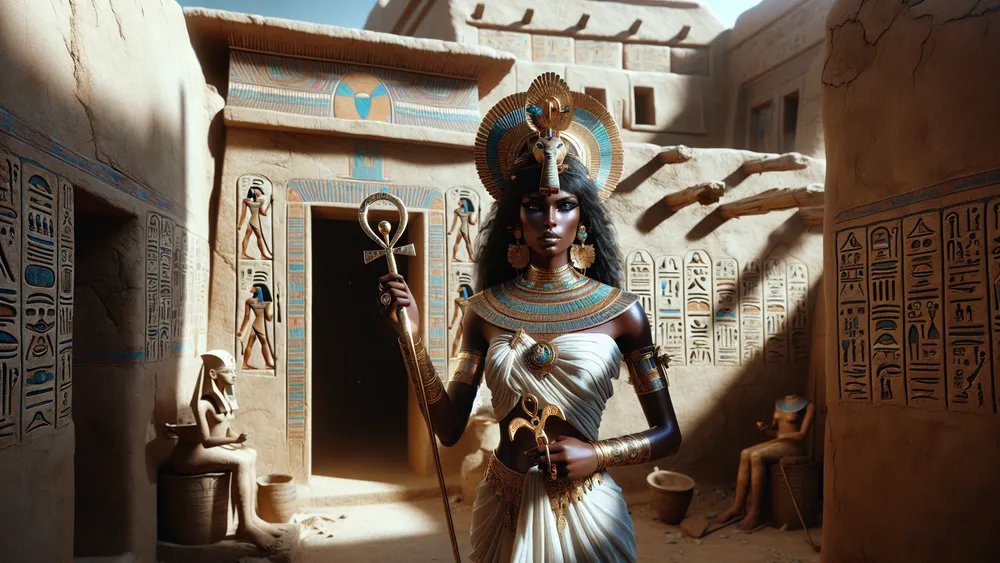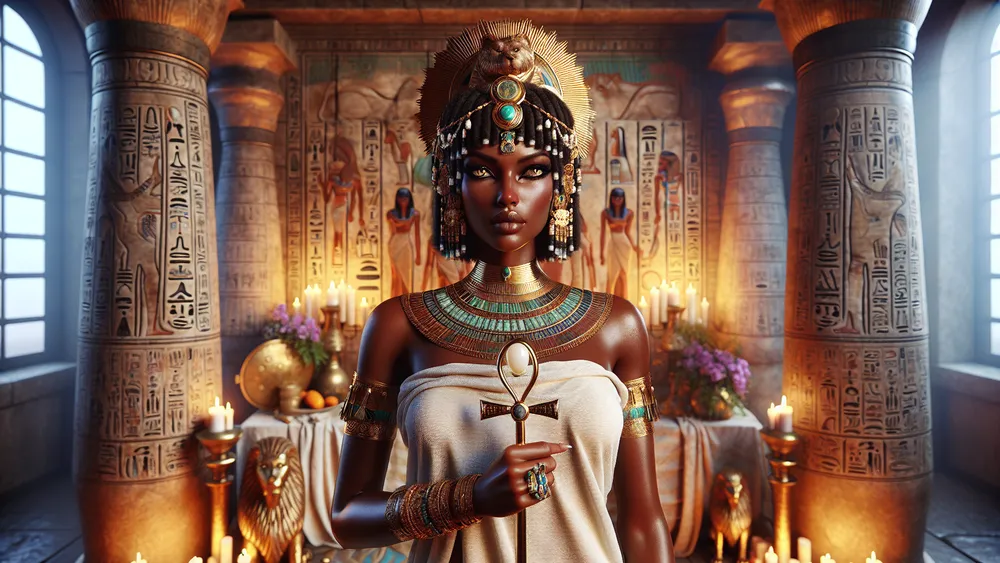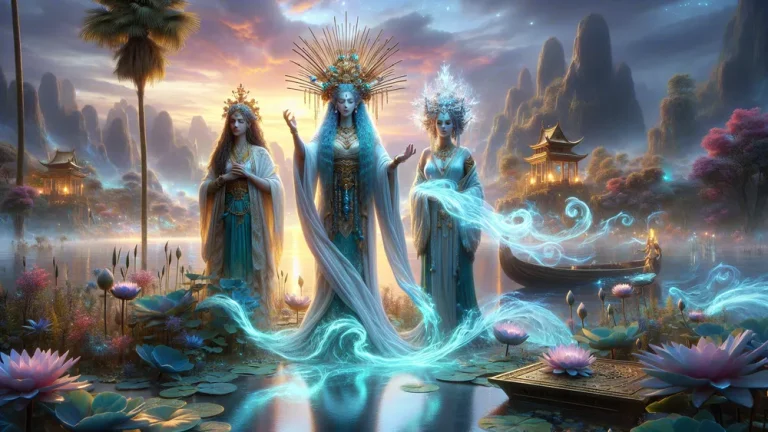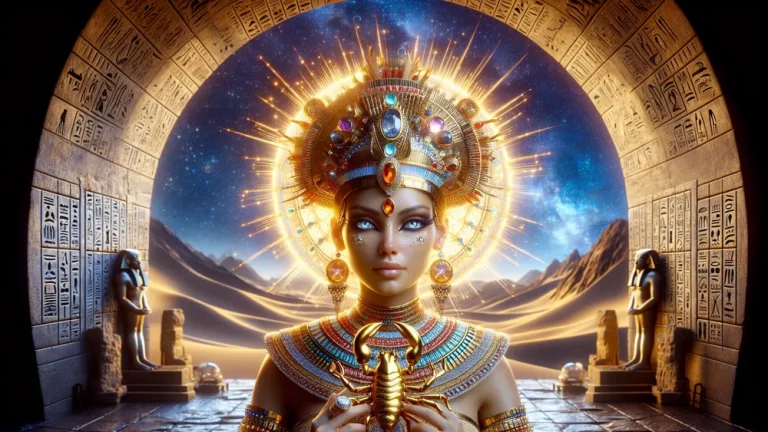Wosret: Egyptian Goddess Of Protection And Power
In the big group of old Egyptian stories, Wosret stands out as a strong and guarding deity. Think of someone who looks out for you, just like today’s security thing that keeps you safe. This blog is going to take you on a trip to find out all about Wosret, the Egyptian goddess of keeping safe and power.
Key Points:
- Wosret is an Egyptian goddess of protection and power.
- She was worshipped mainly during the Middle Kingdom, particularly the 12th Dynasty.
- Wosret’s temples were mostly located in Thebes, a prominent city in ancient Egypt.
- She is symbolized by the scepter and the ankh, representing authority and life.
- Wosret was known for her protective powers and role as a guardian of pharaohs and the state.
- Stories about Wosret emphasize her protective nature and role in maintaining order.
You are going to learn who Wosret is, where she came from, how people in the past looked up to her. You will explore the places dedicated to her, the acts done for her, and the things that stand for her.
And then, you will learn about her guarding powers, her role at the time of the 12th Dynasty, and how she connects to other gods. By finishing this blog, you will know a lot about Wosret’s spot in Egyptian stories and what she left behind.
Wosret: Overview and Key Facts
| Main Thing | Explanation |
|---|---|
| Name | Wosret (also known as Wasret or Wosyet) |
| Role | She is the goddess for protection and power |
| Word Meaning | “Wosret” translates to “the powerful one” |
| When Important | Worshipped a lot during the Middle Kingdom, mainly the 12th Dynasty |
| Where Temples Are | Temples mostly found in Thebes |
| Things Linked | Linked with the scepter and the ankh |
| How Shown | Usually shown as a woman with a tall crown |
| Other Gods Related To | Related to Amon and Mut later |
| Big Stories | Known for being protective in many stories |
| Importance | Seen as a guardian of the pharaohs and the state |
Getting to Know Wosret
To really understand Wosret’s importance, let us look deeper into who she is, where she came from, and how early ideas present her importance in old Egyptian stories.
Who is Wosret?
Wosret, with her name meaning “the powerful one”, is a big god figure in old Egyptian stories, liked for being a goddess of keeping people safe and strong. Picture Wosret as someone who guards you, like a modern thing that keeps you safe and happy, but her name’s story points outs how strong and protective she is. So, she was critical during the Middle Kingdom, especially in the 12th Dynasty, where people really respected her for protecting the pharaohs and the state. To sum up some things about her:
- Role: Goddess of keeping safe and strong
- Etymology: “Wosret” means “the powerful one”
- Historical Period: Mainly loved during the Middle Kingdom, especially the 12th Dynasty
- Significance: Seen as a guardian of the pharaohs and the state
Wosret, known as the powerful one, was highly valued during the Middle Kingdom, particularly in the 12th Dynasty, for her role as a protective goddess of strength and safety.
Where Wosret Came From
The first time Wosret is mentioned can be seen in old Egyptian writings in the Middle Kingdom, where she is called a strong and protective god figure. Picture Wosret as an early figure in Egyptian society, like a community protector who makes sure everyone is safe and things are stable.
And, her beginnings are very much tied to the city of Thebes, where people first saw her as a local goddess before she became known all over. In old Egyptian society, Wosret was known as a protector of the pharaohs and the state, pointing out strength and care. Stories about her start often points out her role in keeping the place safe and helping keep order. To sum up her early start:
- First Mentions: Seen in Middle Kingdom writings
- Where From: From the city of Thebes
- How Seen: Known as a protector in early society
- Important Stories: Tales show her protective role and keeping order
How People Worshipped Her
To understand how people celebrated Wosret, we get a better understanding of her importance and the ways they honored her.
Main Temples and Hangouts
Wosret was mainly enjoyed in several big temples and places, each serving as a spot for her being liked. Think of these temples as old community centers where people came together to honor Wosret and ask for her protection.
The biggest one was the Temple of Wosret in Thebes, which was a major religious place during the Middle Kingdom. And, another vital place was the shrine at Karnak where she was liked next to other well-known gods. And these temples were not just for worship but also as cultural places where activities and ceremonies were done for Wosret. Here is a table indicating the main temples for her:
| Temple Name | Location | Historical Importance |
|---|---|---|
| Temple of Wosret | Thebes | Major religious site during the Middle Kingdom |
| Shrine at Karnak | Karnak | Liked next to other well-known gods |
| Temple of Medamud | Medamud | Big local place with interesting old finds |
Ceremonies and Rituals
Events and special activities for Wosret were fancy and had deep meaning, pointing out her as a protector god and strong. Picture being at a big festival where people gave food, incense, and valuable things to get Wosret’s blessings. These activities usually had parades, with statues of Wosret carried through streets, there would be music and chanting too.

Priests did special rituals, they said hymns and prayers to honor her and wanted her protection. What mattered about these practices was how they connected the community with the divine, making sure of Wosret’s favor and keeping people safe. These events were not only religious things but also social times, they strengthened community bonds and the cultural identity.
Symbols and Art
To fully understand Wosret’s power, we must look at the symbols and artistic images that present her divine presence.
What Wosret Looks Like
Wosret is often present in old Egyptian pictures with signs that point out her protective and strong nature. Picture a statue or carving where she is seen holding a staff, which stands for authority, and wearing a hat with feathers, presenting her divine rank. Many artifacts also show her with a was-scepter, a sign of power and rule, and an ankh, pointing out life. These drawings or sculptures were more than just decoration since they had meanings that described her traits and jobs. Below is a list of her essential traits and their meanings:
- Staff: Stands for authority and ruling.
- Hat with Feathers: Shows her divine rank and link to the sky.
- Was-Scepter: Sign of power and rule.
- Ankh: Stands for life and forever living.
Wosret’s depictions in ancient Egyptian art symbolize her protective and authoritative nature through objects like the staff, hat with feathers, was-scepter, and ankh, each representing specific traits and roles.
Wosret in Hieroglyphs
Wosret’s name and signs are shown intricately in hieroglyphs, which is an old Egyptian way to write using picture characters. Think about reading an old scroll where her name is indicated with a mix of signs, like the scepter and the ankh, each picture carefully carved to point out her divine traits.
The hieroglyph for Wosret often has the “s” sound points out by a folded cloth and the “t” sound by a loaf of bread, capturing her essence in a visual form. These images were more than just decoration; they had deep meanings in old writings and carvings, used to call upon her presence and power.
By writing her name and signs on temple walls, stone markers, and small charms, the old Egyptians made sure that Wosret’s protective and powerful essence was always there, keeping their lives and their afterlife safe.
Her Powers and Traits
Knowing Wosret’s visual and symbolic signs helps us to dig into her godly powers and traits.
Protective Powers
Wosret’s job as a goddess of protection was a big part of who she was in old Egyptian stories. Think of having a guardian from the gods whose mere presence could scare away bad things and make sure of safety; this is what Wosret was for the old Egyptians. She made people safe by giving them strength and courage, often called on when there was trouble or danger.

Whole villages, too, asked for her help, especially using little charms and carvings that called on her power to keep homes and temples safe. Her protective side was indicated by the scepter and the ankh, which weren’t just signs of power and life but also strong magic objects against harm.
Through these signs and her divine power, Wosret was seen as a powerful shield, making sure those who respected her were safe and well.
Other Godly Traits
Besides being a protector, Wosret had many other godly traits that made her a useful goddess in the Egyptian group of gods. Think of her as a caring figure when it comes to growth; she was thought to bless the land with plenty and make sure the crops and animals were wealthy.
But in the area of war, Wosret’s strong and scary nature made her a big power, often called upon by fighters looking for wins and strength in fights. Moreover, her power reached different parts of daily life, from making sure families were healthy and happy to keeping social rules and fairness.
These many traits made Wosret a full goddess, able to meet the different needs and worries of her followers, presenting both the caring and fighting sides of life.
Wosret Throughout History
After looking at Wosret’s various powers and traits, we should dig into her place in history and the influence she had in different times of ancient Egypt.
Her Influence in the 12th Dynasty
In the 12th Dynasty of Egypt, Wosret’s importance was at its peak, becoming a major part of the religion and power structure. Picture a time, thus, when the kings like Senusret I, used her strength and protective sides to make their rule real and make sure their reigns were stable.
Often, in royal writings and temple gifts, Wosret was called upon, presenting godly approval of the king’s power. But her influence was more than just signs; she was thought to really guide and protect the rulers, like a modern helper or teacher. This close tie with the gods gave the kings a feeling of unbeatability and holy right, making their roles and choices firm.
By honoring Wosret, she became a key part of the 12th Dynasty’s image, shaping how they worshiped and their power tactics.

Historical Mentions and Records
Old writings and books give us interesting looks into Wosret’s importance in old Egyptian life. So, imagine finding an old temple writing where a king says his win in battle is because of Wosret’s holy help. These writings, usually found in places like Karnak, indicate her part as a protector and fighter goddess.
Plus, Wosret indicates up in different holy texts and hymns, and she is known for her strength and caring sides. These notes were not just simple mentions; they were clear signs of her power and importance. For example, the “Coffin Texts,” which are a group of funeral spells, often call on Wosret to make sure safe travel to the next world, indicating her protective nature even in death.
These old mentions prove Wosret’s lasting mark and the deep respect the old Egyptians had for her.
Related Gods and Stories
Since we’ve already looked at Wosret’s old mentions and writings, let’s dig into her links with other gods and tales where she appears.
Her Connections to Other Gods
Wosret’s links to other gods in the Egyptian world show her vital place in the god system. One must picture her ties like teams that made her power and reach stronger. The main gods linked to Wosret include:
- Amon (Amon-Ra): Often linked with Wosret, Amon was a big god whose worship happened mainly in Thebes, where Wosret was also honored. Their tie presents her importance in that area.
- Mut: A mother goddess, Mut’s caring sides fit well with Wosret’s protective traits, forming a god-team that points out both care and strength.
- Khonsu: The moon god Khonsu, often indicated as young, is sometimes seen as a heavenly child of Wosret and Amon, indicating the ongoing heavenly protection and direction.
These links indicate how Wosret was mixed into the tales of Egyptian gods, working with other gods to form a united and dependent god group. Surely her work with these gods was not just signs, but also presented how many sides of life, from guarding and caring to helping and ongoing direction, were connected.

Myths About Wosret
Picture a story where Wosret, the strong goddess of safety, stands as a guard against disorder and bad forces. One such story speaks of Wosret keeping Thebes safe from evil powers, presenting her role as a tough protector.
In another tale, she helps guide the spirits of dead people through the dangerous trip to the next life, making sure they get there safely. These stories are not just for fun; they hold deep moral and cultural meanings. They stress the ideas of safety, help, and the win of order over disorder, showing the old Egyptians’ belief in the need for holy guards and good behavior.
From these stories, Wosret’s image indicates the ideals of power and kindness, acting as a holy model for the people who honored her.
Pantheon of Egyptian Gods
The group of Egyptian gods is a huge and detailed mix of gods, each having their own special duties and tales. Consider it as a big, linked family where everyone has a specific job, from making things and protecting people to fertility and afterlife. This variety presents the complexity and richness of old Egyptian thoughts.
For looking at the whole list of Egyptian gods and their interesting tales, visit this Egyptian gods list. This big guide will help you dig deeper into Egyptian myths and see the many ways these gods affected daily life and habits.
FAQs
1. Who was Wosret in Egyptian mythology?
Wosret in Egyptian mythology was a goddess of protection and power, often associated with Thebes and revered for her strength and guardianship.
2. What symbols are associated with Wosret?
Symbols associated with Wosret include the scepter and the Was-scepter, representing power and dominion.
3. Where were Wosret’s main temples located?
Wosret’s main temples were located primarily in Thebes, which was a significant religious and cultural center in ancient Egypt.
4. How did Wosret influence the 12th Dynasty?
Wosret influenced the 12th Dynasty by being a protective deity whose worship was particularly emphasized by the ruling pharaohs, thereby reinforcing their divine right to rule.







